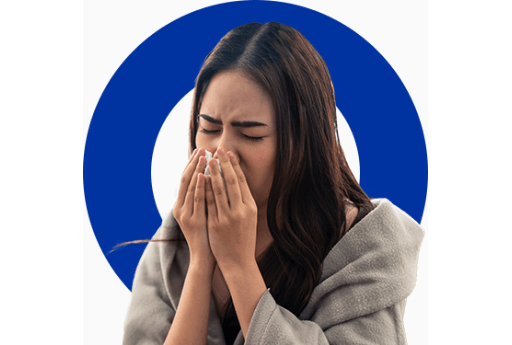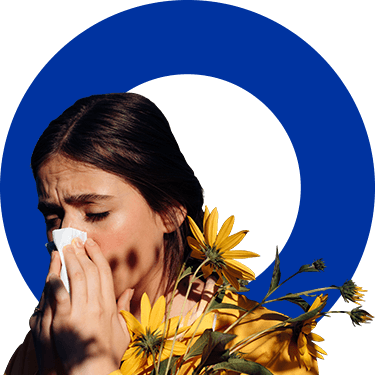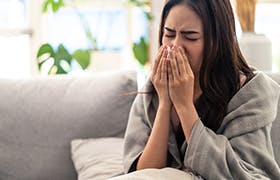Understanding common cold, sinusitis and allergic rhinitis symptoms.
Whether you have a cold, blocked sinuses, or allergic rhinitis flaring up, the right treatment can help you get some relief and feel normal again.
Identify the problem – is it a cold, an allergic rhinitis or sinusitis?
Congestion and other nasal symptoms could be due to various things – including the common cold, allergies or a case of sinusitis. Understanding which condition is causing your symptoms is the key to finding the right treatment for you.
Do I have a cold?
A cold is a viral infection that can be triggered by more than 200 types of virus. Common cold symptoms include nasal congestion, a runny nose, sore throat, cough, tiredness and sneezing.1
If you’ve found yourself wondering “what are the symptoms of the flu and how do they differ from a cold?” don’t worry – the two are often confused. Essentially, the main differences between a cold and the flu are that you are more likely to have fatigue, fever and muscle pain with flu than with a cold, and colds will usually get better quicker.2
Most of us will catch a cold two to three times a year.3 A cold virus can be spread in the air through coughs and sneezes or picked up by touching infected people or surfaces. An infected person can be contagious from the day before the illness breaks out and can remain infectious for several weeks. Cold symptoms typically reach their worst two to three days after infection.3
Rest and symptom relief are the best things for cold treatment.3 Otrivin offers a range of nasal decongestant product options to help relieve a blocked or stuffy nose.

Do I have allergic rhinitis?

Allergic rhinitis flares up when your immune system overreacts to an allergen such as dust, pollutant, pollen, mould or pet hair, as it would a viral infection, releasing chemicals to fight it off. Allergic rhinitis symptoms include sneezing, a runny or blocked nose, and itchy eyes, mouth or skin.4
People with allergic rhinitis can start to experience symptoms just minutes after breathing in an allergen.5
Allergic rhinitis symptoms can significantly impact daily life for people who suffer from it. Depending on the severity of symptoms, allergic rhinitis can have psychological effects, interfere with social interactions, and even have an economic burden.6 That’s why finding ways to treat your symptoms and avoiding triggers is so important in managing allergic rhinitis.
Do I have sinusitis?
Sinusitis is symptomatic inflammation of the paranasal sinuses and usually follows a viral infection of the upper respiratory tract, such as a cold or flu. Sinusitis symptoms include pain, swelling, and tenderness around the face, in addition to the normal cold symptoms of a runny or blocked nose.7
Sinusitis, also called rhinosinusitis, affects about 1 in 8 adults every year, and generally occurs when viruses or bacteria infect the sinuses (often during a cold) and begin to multiply. Part of the body’s reaction to the infection causes the sinus lining to swell, blocking the channels that drain the sinuses. This causes mucus and pus to fill up the nose and sinus cavities.8
Sinusitis can be acute (lasting less than four weeks), or chronic (lasting for more than three months). Sinusitis treatment includes daily nasal irrigation, and with Otrivin naturals range, can help clear your nose, reduce swelling, and wash away any trapped bacteria and viruses from the nose.9

References:
- Eccles R, Martenssen K, Chen S. Effects of intranasal xylometazoline, alone or in combination with ipratropium, in patients with common cold. Curr Med Res Opin. 2010;26:889–899
- NICE CKS. Common cold. Available from: https://cks.nice.org.uk/common-cold#!background (last accessed March 2020)
- American College of Allergy, Asthma and Immunology. Allergic Rhinitis. Available from: https://acaai.org/allergies/types/hay-fever-rhinitis (last accessed March 2020)
- NICE CKS. Allergic rhinitis. Available from https://cks.nice.org.uk/allergic-rhinitis#!backgroundSub:2 (last accessed March 2020)
- NICE. Sinusitis. Available from: https://cks.nice.org.uk/sinusitis#!diagnosisSub (last accessed March 2020)
- Rosenfeld RM, Piccirillo JF, Chandrasekhar SS, et al. Clinical Practice Guideline (Update): Adult Sinusitis. Otolaryngol–Head Neck Surg. 2015;152(2S):S1–S39
- Goodman DM, Lynm C, Livingston EL. Adult Sinusitis. J Am Med Assoc. 2013;309(8):837
- NHS. Sinusitis (sinus infection). Available from: https://www.nhs.uk/conditions/sinusitis-sinus-infection/ (last accessed March 2020)
Show all references
Close references








